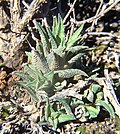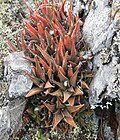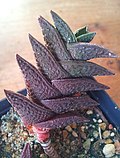Haworthiopsis

| Haworthiopsis | |
|---|---|
 | |
| Haworthiopsis attenuata | |
| Scientific classification | |
| Kingdom: | Plantae |
| Clade: | Tracheophytes |
| Clade: | Angiosperms |
| Clade: | Monocots |
| Order: | Asparagales |
| Family: | Asphodelaceae |
| Subfamily: | Asphodeloideae |
| Tribe: | Aloeae |
| Genus: | Haworthiopsis G.D.Rowley[1] |
| Type species | |
| Haworthiopsis coarctata | |
Haworthiopsis is a genus of succulent plants in the subfamily Asphodeloideae. The genus was previously included in Haworthia. Species in the genus are typically short perennial plants, with leaves often arranged in a rosette and frequently having raised white markings. The two-lipped flowers are borne on a tall stalk and are small – less than 17 mm (0.7 in) long – and pale in colour. Many species are cultivated as house plants or by succulent enthusiasts.
Description
[edit]Haworthiopsis species are short perennial plants, with or without an obvious stem. The leaves either form a rosette or are arranged in various spirals on a more extended stem.[2] Individual leaves are smooth or have white markings, which may take the form of small protuberances (tubercules) or be more pointed, almost spine-like. The white markings may be on the lower surface of the leaf only, or on both surfaces, and may also extend to the leaf margins. The upper leaf surfaces are "windowed" in some species, and the margins may have toughened teeth.[3][4]
The flowers are borne in a raceme on a long, stiff stalk (peduncle) which also bears a few bracts without flowers in their junctions with the stalk. Each flower is less than 17 mm (0.7 in) long, with white to green, pink or brown tepals, forming a two-lipped (bilabiate) structure with a hexagonal or rounded hexagonal base. Both the outer and inner tepals are joined together at their bases. The stamens and the style are enclosed within the tepals. The fruit is a narrowly ovoid capsule with black or dark brown seeds.[3][4]
Two-lipped flowers were considered a distinguishing characteristic of the genus Haworthia, before Haworthiopsis and Tulista were split off. More detailed features of the flowers now identify the three genera. In Haworthiopsis, the flowers and their styles are usually straight rather than curved; the outer and inner whorls of three tepals are joined to one another at the base; and the flowers taper smoothly into the flower stem (pedicel) rather than being broader at the base with a sharp junction.[3]
Taxonomy
[edit]The genus Haworthiopsis was erected by Gordon Rowley in 2013,[1] with the type species Haworthiopsis coarctata.[3] The ending -opsis derives from the Greek ὀψις (opsis), meaning 'appearance',[5] hence Haworthiopsis means "like Haworthia".
The taxonomic history of the genus is complex. In 1753, Carl Linnaeus followed authors before him in using the genus Aloe for a wide range of plants now placed in the tribe Aloeae by those using the broad circumscription of the family Asphodelaceae (sensu APG III onwards). Linnaeus's Aloe species included two now placed in Haworthiopsis. The genus Haworthia was established by Henri Auguste Duval in 1809 for former Aloe species with smaller whitish two-lipped (bilabiate) flowers. Many additional taxa were later added, at both species and infraspecies ranks. This has been described as "causing a great deal of confusion".[4] In 1971, M.B. Bayer divided Haworthia into three subgenera: H. subg. Haworthia, H. subg. Hexangulares and H. subg. Robustipedunculatae.[6]
Phylogenetic studies, particularly from 2010 onwards, showed that Haworthia and other genera related to Aloe were not monophyletic.[7][8] Accordingly, in 2013, Rowley separated most of the species formerly placed in Haworthia subg. Hexangulares into a new genus, Haworthiopsis.[9] Haworthiopsis was revised in 2013 by Manning et al. so that the genus more closely correlated with the former subgenus,[3] a revision described as "more coherent" by Gildenhuys and Klopper in 2016.[4]
Sections and Species
[edit]In 2016, Gildenhuys and Klopper proposed a division of the genus into seven sections, although noting that it could need re-evaluation when further phylogenetic studies had been carried out. Their section Koelmaniorum is least clearly placed in the genus, and the status of sections Limifoliae and Tessellatae is also uncertain.[4]
As of October 2017[update], the World Checklist of Selected Plant Families accepted the following species:[10]
| Section | Image | Scientific name | Description | Distribution |
|---|---|---|---|---|
| Attenuatae |  | Haworthiopsis attenuata (Haw.) G.D.Rowley | South Africa (southern Cape Provinces) | |
| Haworthiopsis |  | Haworthiopsis coarctata (Haw.) G.D.Rowley | small, smooth, rounded tubercles | South Africa (southern Cape Provinces) |
 | Haworthiopsis fasciata (Willd.) G.D.Rowley | has a light color, and fibrous leaves with glabrous inner surfaces | South Africa (southern Cape Provinces) | |
 | Haworthiopsis glauca (Baker) G.D.Rowley | has a blue ("glaucous") colour | South Africa (southern Cape Provinces) | |
 | Haworthiopsis longiana (Poelln.) G.D.Rowley | has long, thin, elongated leaves | South Africa (southern Cape Provinces) | |
 | Haworthiopsis reinwardtii (Salm-Dyck) G.D.Rowley | has larger, flatter, whiter tubercles, and is often more slender than H. coarctata | South Africa (southern Cape Provinces) | |
| Limifoliae |  | Haworthiopsis limifolia (Marloth) G.D.Rowley | has splayed leaves usually with raised lateral lines or wrinkles on the leaf surfaces | Eswatini, southern Mozambique, South Africa (KwaZulu-Natal, Northern Provinces) |
| Koelmaniorum |  | Haworthiopsis koelmaniorum (Oberm. & D.S.Hardy) Boatwr. & J.C.Manning | has scabrid, dark brown opaque leaves | South Africa (Mpumalanga) |
| Tessellatae |  | Haworthiopsis granulata (Marloth) G.D.Rowley | South Africa (Cape Provinces) | |
 | Haworthiopsis tessellata (Haw.) G.D.Rowley | Namibia, South Africa (Cape Provinces, Free State, Northern Provinces) | ||
 | Haworthiopsis venosa (Lam.) G.D.Rowley | has visible veins on its upper leaf surfaces | South Africa (south-western Cape Provinces) | |
| Haworthiopsis woolleyi (Poelln.) G.D.Rowley | South Africa (southern Cape Provinces) | |||
| Trifariae |  | Haworthiopsis nigra (Haw.) G.D.Rowley | has a dark colour and concolorous tubercles | South Africa (southern Cape Provinces) |
 | Haworthiopsis pungens (M.B.Bayer) Boatwr. & J.C.Manning | has hard, sharp ("pungent") leaf tips | South Africa (southern Cape Provinces) | |
 | Haworthiopsis scabra (Haw.) G.D.Rowley | a stemless species with a rough scabrid leaf surface | South Africa (south-western and south-south-western Cape Provinces) | |
 | Haworthiopsis viscosa (L.) Gildenh. & Klopper | has a lighter brown mat surface, and no tubercles | South Africa (Cape Provinces) | |
| Virescentes |  | Haworthiopsis bruynsii (M.B.Bayer) G.D.Rowley | Has evolved a retuse shape, but is nonetheless a member of the genus. | South Africa (southern Cape Provinces) |
 | Haworthiopsis sordida (Haw.) G.D.Rowley | has dark, dusty ("sordid") leaves with rounded tips | South Africa (southern Cape Provinces) |
References
[edit]- ^ a b "Haworthioposis", World Checklist of Selected Plant Families, Royal Botanic Gardens, Kew, retrieved 2017-10-16[permanent dead link]
- ^ Molteno S. (2022), "Phyllotaxis in Asphodelaceae subfam. Alooideae: a tool in taxon delimitation." Haseltonia 28(1), https://doi.org/10.2985/026.028.0107
- ^ a b c d e Manning, John; Boatwright, James S.; Daru, Barnabas H.; Maurin, Olivier & Bank, Michelle van der (2014), "A Molecular Phylogeny and Generic Classification of Asphodelaceae Subfamily Alooideae: A Final Resolution of the Prickly Issue of Polyphyly in the Alooids?", Systematic Botany, 39 (1): 55–74, doi:10.1600/036364414X678044, S2CID 86714657
- ^ a b c d e Gildenhuys, Sean D. & Klopper, Ronell R. (2016), "A synoptic review and new infrageneric classification for the genus Haworthiopsis (Xanthorrhoeaceae: Asphodeloideae)" (PDF), Phytotaxa, 265 (1): 1–26, doi:10.11646/phytotaxa.265.1.1, hdl:2263/57046, retrieved 2017-10-18
- ^ Stearn, W.T. (2004), Botanical Latin (4th (p/b) ed.), Portland, Oregon: Timber Press, p. 257, ISBN 978-0-7153-1643-6
- ^ Bayer, M.B. (1971), "Changes in the genus Haworthia", Cactus and Succulent Journal (US), 43: 157–162, retrieved 2017-10-18
- ^ Klopper, R.R.; Van Wyk, A.E. & Smith, G.F. (2010), "Phylogenetic relationships in the family Asphodelaceae (Asparagales)", Biodiversity and Ecology/Schumannia, 3: 9–36, retrieved 2017-10-18
- ^ Daru, B.H.; Manning, J.C.; Boatwright, J.S.; Maurin, O.M.; Maclean, N.; Kuzmina, M. & van der Bank, M. (2013), "Molecular and morphological analysis of subfamily Alooideae (Asphodelaceae) and the inclusion of Chortolirion A. Berger in Aloe L.", Taxon, 62 (1): 62–76, doi:10.1002/tax.621006, hdl:10566/3363, JSTOR 24389313
- ^ Rowley, G.D. (2013), "Generic concepts in the Alooideae 3: The phylogenetic story", Alsterworthia International Special Issue, 10: 1–7; cited in Gildenhuys & Klopper (2016)
{{citation}}: CS1 maint: postscript (link) - ^ "Search for Haworthiopsis", World Checklist of Selected Plant Families, Royal Botanic Gardens, Kew, archived from the original on 2017-10-17, retrieved 2017-10-16



